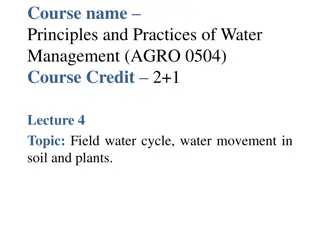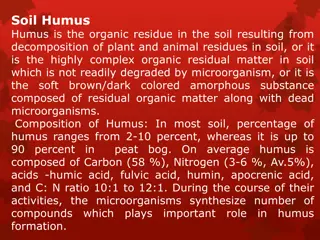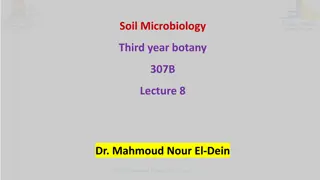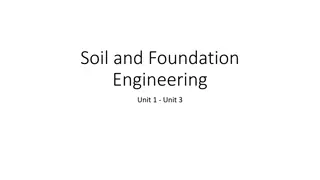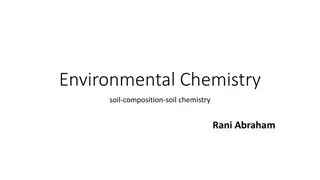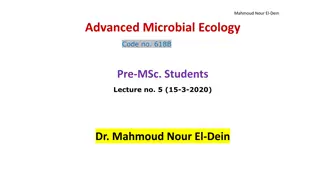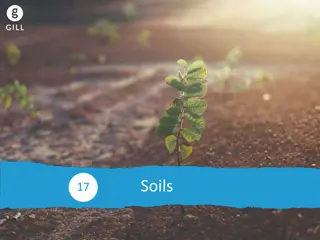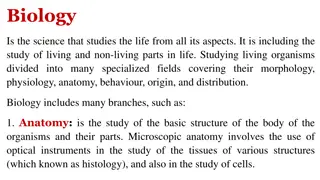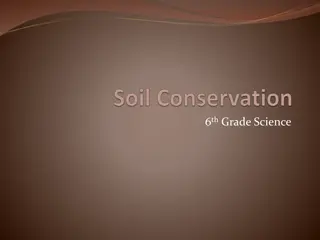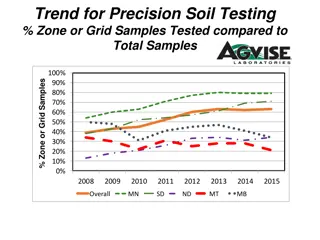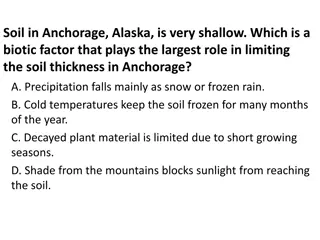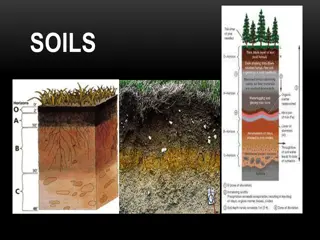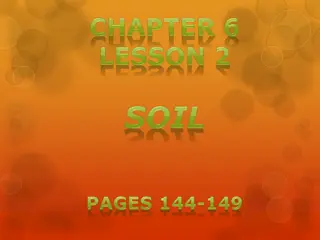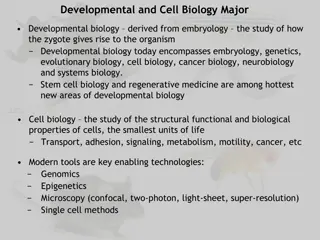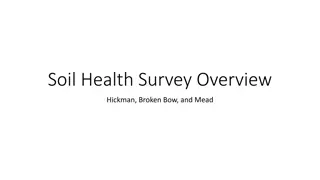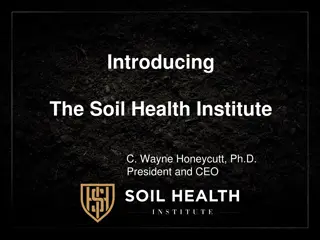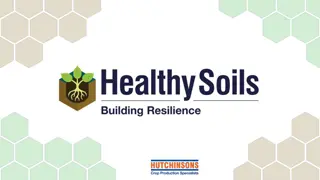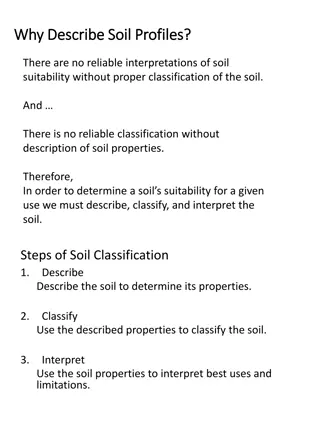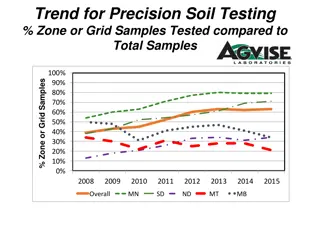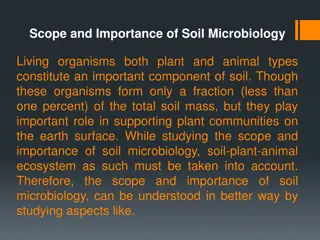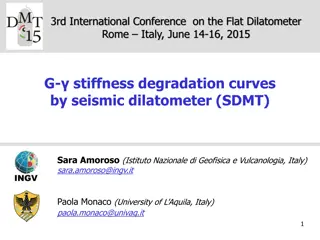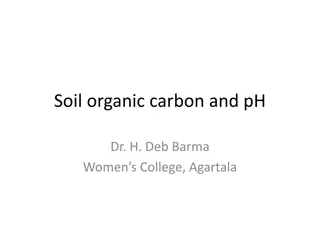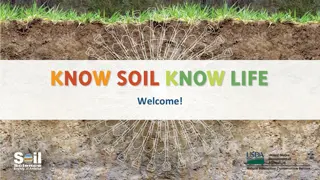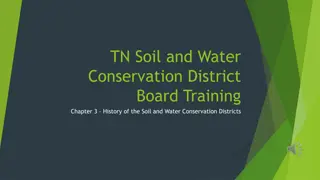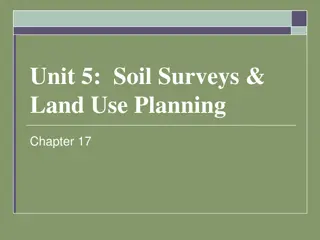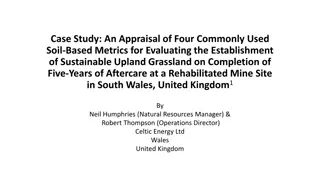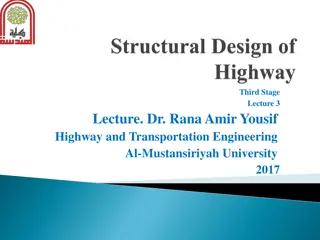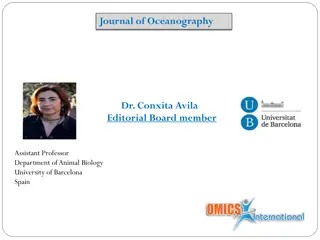Principles and Practices of Water Management in Agriculture
This course delves into the field water cycle, water movement in soil and plants, soil-plant-water relationships, water dynamics in the soil-plant-atmosphere system, soil composition, soil texture classification, permeability factors, density of soil solids, total porosity assessment, and energy asp
8 views • 62 slides
Evaluation of SPLASH and HRRR Soil Moisture Comparison
This study compares soil moisture data between the HRRR model and SPLASH observations during the 2022 warm season. It explores differences in soil moisture levels at various depths, evaluates responses to precipitation events, and drydown periods. The research focuses on analyzed data from HRRR Mode
3 views • 12 slides
Effective Methods for Soil Conservation
Methods to reduce soil erosion and promote soil conservation include terracing, contour planting, strip cropping with cover crops, alley cropping, agroforestry, windbreaks, and conservation tillage practices such as no-till and minimum tillage. These methods help in minimizing soil erosion hotspots
2 views • 11 slides
Introduction to Synthetic Biology: Understanding the Core Concepts and Applications
In this introductory lecture on synthetic biology, you will explore the fundamental principles of engineering biology, including the design and construction of new biological entities. The focus is on leveraging molecular, cell, and systems biology advancements to create biological systems that can
1 views • 89 slides
The Importance of Humus in Soil Health
Humus, the organic residue in soil, plays a crucial role in soil fertility and plant growth. It improves soil structure, retains water, stores essential nutrients, and promotes microbial activity. Factors like soil fertility, moisture, temperature, and pH influence the distribution and activity of s
0 views • 21 slides
Composition of Soil Organic Matter in Soil Microbiology
Soil organic matter is vital for soil properties and plant nutrition. It consists of plant residues, animal remains, and microbial tissues, comprising complex compounds like carbohydrates, proteins, fats, and more. The composition varies with plant type, age, and nature. Leguminous plants are rich i
0 views • 19 slides
Soil and Foundation Engineering Fundamentals
Soil plays a crucial role in engineering, with unique properties that influence its mechanical behavior. This article covers the formation of soil, types including residual and transported soils, and the phases of soil in nature. Explore phase diagrams, relationships between volume, void ratio, and
0 views • 20 slides
Soil Disinfestation Methods for Greenhouse Crop Production
Soil mixes for greenhouse production are carefully designed to optimize water retention and aeration. Proper management of artificial soil mixes can yield crops equal to those grown in topsoil. Sterilization of growing media is crucial, with techniques such as steam sterilization and fumigation comm
0 views • 11 slides
Soil Chemistry and Redox Reactions in Environmental Chemistry
Soil chemistry plays a crucial role in sustaining healthy soils by influencing nutrient availability through oxidation and reduction processes. Redox reactions in soil are impacted by factors like oxygen content and water presence, affecting nutrient supplies. The redox status of soil reflects its n
1 views • 92 slides
The Diversity of Microorganisms in Soil Ecosystems
Microorganisms in soil play crucial roles in soil fertility, nutrient cycling, and industrial product synthesis. They can also be pathogens causing diseases in plants and humans. Soil organisms are broadly classified into two groups: soil flora and soil fauna, consisting of various microorganisms li
0 views • 57 slides
Soil Composition and Importance
Explore the world of soil and its significance as a natural resource by discovering its composition and how it affects plant growth. Learn about the main ingredients of soil, its permeability, and the role of water, air, and organic matter. Gain insights into how soil supports plant life through lea
1 views • 30 slides
Construction Safety and Soil Mechanics Overview
This content provides valuable information on excavation, trenching, soil mechanics, OSHA regulations, common violations in construction and excavation, fatal incidents, soil composition, and soil weight calculations. It emphasizes the importance of following safety protocols in construction work re
0 views • 45 slides
The Fascinating World of Biology and Human Biology
Biology is a broad scientific field encompassing the study of living organisms and their various aspects, from anatomy and physiology to genetics and evolution. Branches of biology include anatomy, histology, cytology, physiology, embryology, genetics, molecular biology, biochemistry, zoology, botan
0 views • 21 slides
Soil Erosion and Conservation in 6th Grade Science
Soil erosion is the process of soil wearing away, commonly caused by natural forces like wind, water, gravity, and ice, as well as human activities such as farming, mining, and construction. Severe weather events can accelerate soil erosion. Soil conservation techniques like crop rotation, conservat
0 views • 12 slides
Soil Chemistry and Mineralogy Analysis at CSU Summer Soil Institute
Explore the comprehensive analysis of soil chemistry, texture, and mineralogy conducted at the CSU Summer Soil Institute in July 2010. The study delves into pedology, elemental composition, particle size distribution, X-ray diffractometry, and mineralogical composition of various soil samples. Detai
0 views • 22 slides
Soil Moisture Retrieval Over Bare Surfaces Using Radar Observations
This study focuses on retrieving soil moisture over bare surfaces using radar observations and a lookup table representation of forward scattering. The research aims to develop a non-empirical and simple method for accurate soil moisture retrieval without the need for ancillary information. Issues w
0 views • 14 slides
Trends in Precision Soil Testing and Average Soil Nitrate Levels (1986-2015)
This detailed content provides insights into the trends in precision soil testing, comparing zone/grid samples to total samples, and the variability of soil nitrate levels following wheat and barley crops. It includes visual representations of data from various regions and years, offering valuable i
0 views • 39 slides
Soil Characteristics and Ecosystem Interactions
This content explores various aspects of soil characteristics, including factors influencing soil thickness, the role of bedrock in soil quality, optimal soil mixtures for plant growth, the impact of living organisms on weathering, and the formation of soil. It also discusses how animals can help so
0 views • 17 slides
Soil: Formation, Composition, and Impact on Plant Growth
Soil is more than just dirt; it plays a vital role in supporting plant growth. Formed through the weathering of rocks and organic activity, soil consists of rock fragments, clay, and organic material. The process of soil formation begins with the erosion of bedrock, leading to the development of dif
0 views • 12 slides
Fascinating World of Soil: An Insightful Journey
Delve into the intricate composition of soil through a hand lens to uncover rocks, minerals, and humus. Discover the hidden elements like water, air, and living organisms that form the foundation of soil. Witness the decomposition process by bacteria and fungi, and explore the layers of a soil profi
0 views • 15 slides
Impacts of Prescribed Burning on Soil Fertility in Mediterranean Pastures
This study investigates the effects of prescribed burning on soil fertility and carbon dynamics in Mediterranean mountain pastures. It explores how soil responds to disturbance by prescribed burning, potential legacy effects based on pre-burning conditions, and the role of local microtopography in s
0 views • 8 slides
The World of Developmental and Cell Biology
Developmental biology, stemming from embryology, investigates how organisms evolve from a zygote. It merges various fields like genetics, cell biology, and cancer biology. Cell biology focuses on cell properties and behaviors, using tools like genomics and microscopy. Research areas include cancer c
0 views • 8 slides
Philosophy of Biology: A Methodological Provocation Before the Emergence of Biology
Philosophy of biology before the formal establishment of biology as a discipline explores the evolution of terms and theories related to the science of life. By delving into key philosophical works from the 19th and 20th centuries, the interaction between history, philosophy, and science in the fiel
0 views • 13 slides
Soil Health Survey Overview in Hickman, Broken Bow, and Mead
The Soil Health Survey Overview in Hickman, Broken Bow, and Mead reveals insights into the occupation distribution, utilization of livestock, cover crop practices, obstacles to cover crop use, and incentives driving changes to improve soil health in these regions. Farmers, landowners, and consultant
0 views • 6 slides
Factors of Soil Formation and Soil Geography
Soil formation is a complex process influenced by factors like weathering, organic matter, and minerals. Soil geography studies soil distribution using geographic methods and cartography. Various definitions of soil highlight its importance for plant growth and as a natural body with distinct horizo
0 views • 20 slides
Soil Health for Sustainable Ecosystems
Soil health, defined as the capacity of soil to function as a living ecosystem supporting plants, animals, and humans, is crucial for sustaining life. This content explores the imperatives, opportunities, and key practices such as no-till and cover crops to enhance soil health. It also delves into d
0 views • 33 slides
Microbial Transformations of Nitrogen in Soil: Factors, Forms, and Impact on Plant Nutrition
Understanding the microbial transformations of nitrogen in soil is crucial for optimizing plant nutrition. Factors such as climate, water supply, cultivation, soil texture, and depth influence the nitrogen content in soil. The different forms of soil nitrogen, including inorganic and organic compoun
0 views • 23 slides
Role of Soil Biology in Lawn Care
Soil biology plays a crucial role in maintaining healthy and vibrant lawns. Various organisms, including invertebrates, plant roots, mycorrhizae, and micro-organisms, contribute to functions such as soil structure maintenance, regulation of soil hydrological processes, gas exchange, carbon sequestra
0 views • 27 slides
Importance of Describing Soil Profiles for Soil Suitability Analysis
Proper classification and interpretation of soil properties through describing soil profiles are essential in determining soil suitability for various uses. Soil classification involves describing, classifying, and interpreting soil properties to understand the best uses and limitations of the soil.
0 views • 5 slides
Trends in Precision Soil Testing and Soil Nitrate Levels in Agriculture
Explore the trends in precision soil testing, zone/grid samples compared to total samples, nitrate levels following wheat and canola crops, and soil nitrate variability between fields in Canada. The data spans from 1986 to 2015, showcasing shifts in agricultural practices and soil health indicators
0 views • 35 slides
Scope and Importance of Soil Microbiology in Ecosystems
Soil microbiology plays a significant role in supporting plant communities and maintaining soil health. Living organisms, both plant and animal types, form only a small fraction of soil mass but are crucial for processes like plant growth, organic matter decomposition, humus formation, and biogeoche
0 views • 14 slides
Insights into Soil Stiffness Degradation Using Seismic Dilatometer Data
This content discusses the analysis of soil stiffness degradation curves using data collected from the Flat Dilatometer and Seismic Dilatometer tests. Researchers Sara Amoroso and Paola Monaco present methods for deriving in situ G- decay curves and evaluating shear strain data in various soil types
0 views • 18 slides
Soil organic carbon and pH
Soil organic carbon, a measurable component of soil organic matter, plays a crucial role in soil acidity control, nutrient cycling, and pollutant degradation. Learn about the differences between soil organic carbon and soil organic matter, the composition of soil organic matter, and the distinct fra
0 views • 15 slides
Welcome to Soil Science Workshop
In this workshop, participants will explore various aspects of soil science, including soil sampling, chemistry, biology, climate change, web tools, and resources. The workshop will highlight the importance of studying soil and its impact on life. Participants will engage in discussions and activiti
0 views • 7 slides
History of Soil and Water Conservation Districts in Tennessee
The history of soil and water conservation districts in Tennessee dates back to the Dust Bowl era of the 1930s, leading to the implementation of federal laws and policies focused on soil conservation practices. Timeline highlights events such as the creation of the Soil Erosion Service in 1933, the
0 views • 7 slides
Soil Surveys and Land Use Planning Insights
In Chapter 17, this document delves into the essential aspects of soil surveys and their significance in land use planning. It covers the objectives, methods of evaluation, and interpretation, highlighting the role of electronic databases. This resource provides a comprehensive overview of conductin
0 views • 39 slides
Appraisal of Soil-Based Metrics for Sustainable Upland Grassland in South Wales
An appraisal of four soil-based metrics used to evaluate sustainable upland grassland establishment at a rehabilitated mine site in South Wales, UK, after five years of aftercare. The study, conducted by Neil Humphries and Robert Thompson from Celtic Energy Ltd, assesses the effectiveness of physica
0 views • 14 slides
Soil pH and Its Impacts
Soil pH refers to the negative logarithm of the hydronium concentration in the soil solution. It plays a crucial role in nutrient availability and affects the form in which nutrients are found in the soil. Soil pH levels can impact soil reactions, nutrient availability, and root health. Different ty
0 views • 15 slides
Soil Stabilization Methods
Soil stabilization methods involve mechanical and chemical techniques to improve soil properties for engineering purposes. Mechanical stabilization blends different soil grades, while chemical stabilization involves mixing natural soil with agents like cement, asphalt binders, and lime. Cement stabi
0 views • 13 slides
Dr. Conxita Avila: Marine Biology Professor & Researcher
Dr. Conxita Avila, an Editorial Board member of the Journal of Oceanography, is an Assistant Professor in the Department of Animal Biology at the University of Barcelona. With over 25 years of research experience, she has made significant contributions to marine chemical ecology, Antarctic marine bi
0 views • 18 slides
